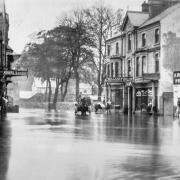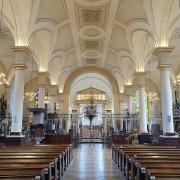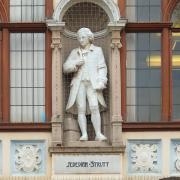The story of Lover's Leap has endured for centuries. Folklore it may be, but, as Nathan Fearn discovers, there's more than a degree of truth to this fascinating gravity-defying tale of love
Stoney Middleton’s Lover’s Leap has featured prominently in Derbyshire folklore for centuries.
A remarkable story which dates back to the mid 18th century, it centres on a heartbroken young lady who jumped from the village’s unforgiving gorges – and miraculously, and fortuitously, survived.
However, whilst many local legends and folklore tales require you to suspend belief, that’s not the case with the story of Hannah Baddeley.
Indeed, what makes this story so remarkable is that it appeared to have really happened.
‘All the research I did absolutely proves that this lady did exist,’ says Colin Hall of the Stoney Middleton Heritage Group.
‘We know, for example, that she was baptised on February 22 in either 1738 or 1739 and that she was buried on December 12 1764, two years after the event that gave Lover’s Leap its name.’
The most widely-held version of events goes that Hannah, the daughter of William Baddeley and Joan Baddeley (nee Townsend), had been courting a local man, one William Barnsley.
Believed to be in her mid-twenties at the time, William’s interest in Hannah cooled and in 1762 he ended the relationship.
Distraught, Hannah ascended the cliffs above Stoney Middleton and jumped, unable to see a future without her lost love.
Miraculously, and mercifully, her decision would not prove fatal as her fall was cushioned by her petticoat, which acted as a parachute on her descent before being caught in brambles branching off from the ledge.
When Hannah reached the bottom, the damage amounted to some superficial cuts and bruises.

As far back as 1841, 83 years after Hannah jumped from the top of the now famous gorge, The Monthly Chronicle – Volume 7 speaks of a public house bearing the name of the ‘Lover’s Leap Inn’.
‘Close beyond it, projecting towards the road, is the bold profile of a rock of tremendous height, apparently divided into stages, fringed by stunted trees, springing from the clefts, where no one would imagine they could find support, breaking its outline and softening the harshness of its aspect,’ The Monthly Chronicle states, before noting: ‘This rock is the scene of a romantic story...’
The lack of first-hand accounts and limited historic resources linked to the event has naturally led to a degree of artistic licence been used down the years as to what exactly transpired on that day.
Whilst Hannah’s fall must have been cushioned sufficiently to allow her to escape the scene with minor injuries, it seems perhaps a stretch to assume she gently and gracefully floated down the gorge to the bottom – as is sometimes reported.
‘Who knows exactly how it played out,’ continues Colin.
‘It’s perhaps unlikely that it happened quite in the way it has sometimes been told down the years, but it’s very likely that, given the topography of the place, someone jumping – whilst incredibly dangerous - could get slowed down and tangled up in what would have been trees, scrub and brambles.
‘Given the clothes they wore in those days, such as petticoats, it’s easy to imagine how that could have happened, even though it was obviously incredibly fortunate that she escaped virtually unharmed.’

Hannah’s great escape has ensured that, over 250 years on, her name remains popular and well-known within Derbyshire folklore.
Her story, though, is ultimately an unhappy one. Records show that she died unmarried two years following the incident, survived by her mother who would pass four years later.
Whilst the cause of death is believed to have been ‘natural causes’ - not particularly unusual for this time despite her young age – some have speculated Hannah’s injuries had in fact been more serious and that her death may have been connected.
What is unarguable is how the story of Lover’s Leap continues to capture the imagination of the Stoney Middleton community - and those further afield – hundreds of years after the event.
‘I think it’s a story that’s very widely known,’ argues Colin.
‘If you asked everyone across Derbyshire if they know Lover’s Leap in Stoney Middleton, a decent proportion would know the story or would at least have heard of it.
‘The dramatic rocks above and the building named and tied to it below, the tale of young love and of course the incredible nature of her survival all makes for a compelling story.’
Indeed, the building directly below the gorge which marks where Hannah fell is as synonymous with the story as the gorge itself.
Starting life as a coaching inn, then a public house, the iconic stone building which morphs into the commanding rocks behind it has since had spells as cafes and restaurants and is now the popular Curry House at Lover’s Leap.

‘It’s great that the building has kept that name ever since,’ says Colin.
‘The construction date of what was then the coaching inn ties in with the event, so it seems evident they were building it at the time and decided to name it after her, which is quite a gesture.
'There’s always been a sign on the wall which explains the story. It’s quite common to see people taking photographs.’
Whilst Lover’s Leap is deeply embedded into the heritage and psyche of Stoney Middleton and its people, it’s by no means the only point of interest there. Not by a long shot.
‘It’s absolutely bonkers,’ laughs Colin. ‘I still pinch myself and ask how so much could happen in such a small place.
‘It’s why the Heritage Centre is going to get built and for me, the hardest task is answering the question - ‘how on earth do we tell it all?’
‘We’ve decided to break it into three sections, otherwise you’d just bamboozle everyone! The heritage exhibition will be called ‘Life in a Gorge’ and will combine both indoor and outdoor activities.
‘The story starts with the site’s geology, which goes back 360 million years. A fascinating story of how the gorge came to be, through the Ice Ages and volcanic activity.
‘Once all that forms and settles, industry takes over. The Romans came and from then to this day the dale has been exploited for the minerals contained within the limestone.
‘The third part of the story is the village both those elements created. The village was only for the purpose of industry so for my money it’s the only true industrial village that really is at the heart of the industry, within the quarries.’
Stoney Middleton has myriad stories to tell – it's quite simply a remarkable place that deserves to be celebrated. Yet its charm lies in its continued authenticity, which will continue to be protected.
‘The heritage building is built and almost complete,’ says Colin.
‘It’s very noticeable because of its huge chimney. It is called the Cupola because that’s what was there back in the 1700s; a smelting mill (cupola) which stood on the exact same site.
‘It’s half a mile out of Stoney Middleton and anyone visiting the village will actually find it difficult to see the heritage trail boards. That was deliberate because the parish council wanted them placing discreetly.
‘It’s great to have a walk around and explore the places and stories that made Stoney Middleton what it is today, but not so it is overexposed – it's an ordinary little village; albeit a remarkable one.’

ANOTHER LEAP OF FAITH... HOLLYWOOD STYLE
It seems fitting (if quite unbelievable) that centuries after Hannah Baddeley made Lover’s Leap famous in Stoney Middleton, the area’s gorges were once again in focus – this time to plunge a mocked-up train carriage into Darlton Quarry in a scene for the Hollywood blockbuster film Mission: Impossible 7, featuring one of the biggest stars on the planet – Tom Cruise.
‘From the point of view of working and filming in Derbyshire, which we did recently on Mission Impossible 7, we found everyone to be so brilliantly helpful - from the local authorities to the people living in the area,’ Hollywood icon Tom Cruise told Derbyshire Life last year.
‘At Stoney Middleton, for instance, we were shooting a scene at the nearby quarry where the countryside is breath-taking. We had to get a full-size train there so some of the roads were closed but the local people were just fantastic. I never heard one complaint, in fact we were warmly welcomed and that meant such a lot to us.
‘The area is breath-taking and I found myself wanting to explore more and more.’
READ MORE: Mission Impossible 7 action sequence filmed in the Peak District

OTHER LOVER’S LEAPS IN DERBYSHIRE
Whilst the Lover’s Leap at Stoney Middleton is arguably the best known in terms of the story attached to it, there are other namesakes dotted around Derbyshire which point to similar tales; some with happy endings and others less so.
The Lover’s Leap found at Dovedale is, as you might expect, a beautiful spot and well-known. It is so named after an incident that supposedly occurred over 200 years ago.
It goes that a young woman climbed to the top of what is now Lover’s Leap and jumped having heard, erroneously, that her partner had been killed in action in the Napoleonic Wars.
Fortunately, her skirt got tangled in branches on the way down and she survived with little more than bumps and bruises.
This particular tale has an even happier ending, as it is said that on returning home she was given the news that far from being lost in battle, her partner was safe and well and returning to England.
Another Derbyshire-based Lover’s Leap story which benefits from a happy ending – at least for the couple concerned – can be found at Lover’s Leap in Ashwood Dale, in the High Peak.
Unlike the aforementioned spots, Lover’s Leap at Ashwood Dale differs in that it is a chasm rather than a cliff edge.
The story goes that two lovers were eloping on horseback against the wishes of their parents, with the aim of getting married at Peak Forest Church.
Having been hotly pursued by their parents, the couple took the literal leap of faith and the horse made it to the other side – leaving them to get married unpursued.

FASCINATING STONEY MIDDLETON
Lover’s Leap may be a huge part of the village’s psyche but it is by no means the only point of interest.
For a small settlement, Stoney Middleton has more than its fair share of notable listed buildings, many which have unique claims to fame.
Dating from the early-to-mid 17th century, Middleton Hall, now a private residence, is a restored manor house hidden away behind St Martin’s Church.
For many years Middleton Hall, found near the centre of the village, was home to the Denham family. It was extended significantly by Thomas Denham, who had the distinction of being Lord Chief Justice of England between 1832 and 1850.
Thomas Denham was also instrumental in the development of The Bath House, better known locally as the Roman Baths after Roman coins were discovered at the site.
The Bath House – comprising two separate baths (one for ladies and one for gentlemen) separated by a wall – each measured three metres x four metres and 1.5 metres deep.
It’s not difficult to see why The Bath House, opposite Middleton Hall, was first founded. Another quirk of Stoney Middleton is its mineral-rich thermal springs.
Whilst these might not be as widely known or celebrated as places such as Buxton, these springs played an important role in the development of the village.
With a natural and constant temperature of 18 degrees Celsius, at their zenith back in the 19th century the baths were popular for the healing power the water was perceived to possess.

The aforementioned St Martin’s Church was built in the 15th century by Joan Eyre in thanks for the safe return of her husband from the Battle of Agincourt.
A highly unusually-designed building, it features the oldest of just two surviving octagonal naves in Britain.
Another octagonal-shaped Stoney Middleton building is its Toll House, which once charged for use of the road it stands on – created by blasting through Middleton Dale in 1830. These days, it is England’s only Grade II-listed fish and chip shop!
READ MORE: Tollbar - Stoney Middleton’s historic fish and chips shop
Tales of notorious past events also abound in Stoney Middleton – many of which are based in fact.
These include ‘Black Harry’, an 18th century highwayman who preyed on travellers and who eventually got his comeuppance; the murder of a dubious Scottish Pedlar at the Moon Inn (which still exists) in the 1740s; and the murders of elopers Allen and Clara in April 1758 who had left Stoney Middleton on horseback to get married at Peak Forest.
The couple tragically never made it. Having stopped over at the Royal Oak the night before, they set off the following day only to be attacked and killed near Castleton by miners for their possessions.
Clara’s saddle was kept in the Royal Oak before it closed and now resides at the Castleton Museum.
Stoney Middleton also served as a camp during World War Two for Italian and German POWs, as well as displaced persons who were set to work in the quarries. Descendents still reside in the village to this day.

THE BOUNDARIES OF LOVE
When thinking of the Great Plague of 1665, most will naturally think of the ‘Plague village’ of Eyam.
However, the role of Stoney Middleton, Eyam’s closest neighbouring village, cannot be understated.
The boundary stone, found midway between the villages with six holes (which would have been soaked in vinegar in the belief it would kill infection) drilled into its surface still exists.
‘Eyam villages relied predominantly on their neighbours in Stoney Middleton to leave them a great amount of goods each day at the boundary stone,’ explains Colin.
To this day, the villages mark the sacrifices made, and the bravery shown, in the form of an annual remembrance service held at Cucklett Delf on the edge of the village every Plague Sunday.
The service also marks the extremely poignant story of Emmott Sydall and Rowland Torr.
‘Emmott and Rowland were a young couple betrothed to each other but separated during the Plague,’ says Colin.
‘Emmott, a young girl of around 22, lived across from Mary Cooper’s house in Eyam where the Plague had started, whilst Rowland lived close by in Stoney Middleton.
‘When it was no longer safe for Rowland to visit Emmott – whose father and four siblings had been some of the first victims – they would meet in secret and at a distance either side of the boundary stone.
‘Emmott stopped appearing towards the end of April 1666, although Rowland continued to go in the forlorn hope she would appear – but she never did.
‘Once the Plague subsided, Rowland was one of the first to re-enter Eyam but was told what he had feared – Emmott had succumbed to the Plague in the April.
‘There’s a stain glass window in the church which commemorates their sad story.’




























